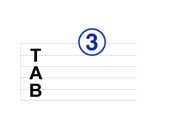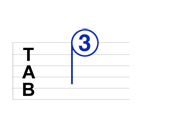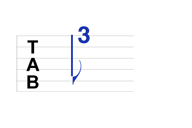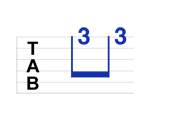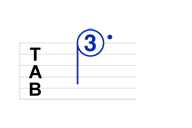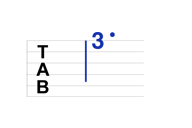Guitar tablature is commonly used around the world for guitar notation. Learning how to read guitar tabs gives you access to a wealth of guitar songs. You can learn how to read guitar tabs in 5 easy steps. Reading tablature is even easy for beginners!
What Are Guitar Tabs?
Guitar Tablature (TAB or tab) is a system of guitar music notation, dating back to the 16th century, that indicates which frets to press. The lines indicate the strings and the numbers indicate the fret positions. Tab does not show which finger is used to hold the string against the fret.
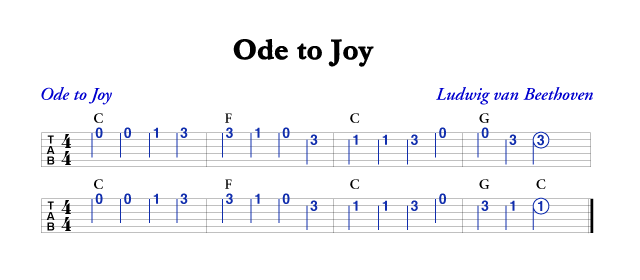
An example of guitar tablature (a guitar tab)
1. How to Read Guitar Tabs Notes
Basic guitar tabs look like numbers across on a stack of 6 horizontal lines. The bottom line represents the thickest string (the string closest to you as you hold the guitar).
 Numbers placed on the lines indicate the fret you use to play a note
Numbers placed on the lines indicate the fret you use to play a note
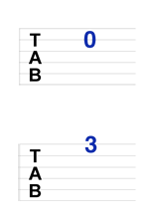 The
The 0
seen in the tab to the left means that the B string (your 2nd string) should be played as an open string.
The 3
seen in the tab to the left shows you to place your finger just below the 3rd fret on the high E (1st) string. Fret numbers (1, 2, 3, etc.) are counted starting at the nut (the end of the guitar neck with the tuning keys).
Guitar tabs are read from left to right. Numbers stacked vertically indicate notes which are played at the same moment in time (as with guitar chords or partial chords). In learning how to read guitar tabs, it’s important to read slightly ahead. Be prepared so you don’t hesitate to play the next note and fall out of rhythm.
Practice slowly and focus on getting your fingers to the right frets at the right time. Make sure to take routine breaks. At first your fingers will tire easily. Remember, you’re building muscles! Also, your fingers might hurt at first but will eventually develop calluses and stop hurting.
Note that eMedia Guitar Method and Interactive Rock Guitar make learning how to read guitar tabs easy. The interactive guitar lesson software will actually listen to you play through your computer’s microphone and shows you your mistakes. Interactive flash cards make learning how to read guitar tabs quick and easy. Some of the information presented in this article is borrowed from the eMedia guitar lesson software.
2. Count Rhythms and Know the Song’s Time Signature
At the beginning of well-notated tabs you will see a time signature. This is used to help you keep rhythm in the song. The most common time signatures are 4/4 and 3/4.
The top number of the time signature indicates how many counts per measure. The bottom number indicates what note receives one count (i.e. 4 means the quarter note gets one count and 8 would mean the eighth note gets one count).
3. Learn How To Read Guitar Tabs with Rhythmic Notation
High quality tabs will have rhythmic notation for the notes. Note durations and rhythm are indicated by a system similar to the one used in standard music notation, with the fret number in a circle or next to the stem.
Circled note no stem = whole note and gets 4 counts.
Circled note with a stem = half note and gets 2 counts.
Stem only = quarter note and gets 1 count.
Stem with flag = eighth note and gets half a count.
Consecutive eighth notes are usually connected with one line
(each of the eighth notes still gets half a count).
Dotted Note Values
A dot following any note increases its duration by half the original value.
Dotted half note gets 3 counts.
Dotted quarter note gets 1 1/2 counts.
4. Special Symbols
Below are a few special symbols people use in TABs to indicate some common guitar techniques. If you want to learn how to read guitar tabs in rock and blues styles, then you particularly need to know these.
p = pull off
h = hammer on
\ = slide (downward)
b = string bend
/ = slide (upward)
~ = string vibrato
eMedia Interactive Rock Guitar and eMedia Intermediate Guitar Method teach guitar techniques such as hammer ons, pull offs, slides, bends, and vibrato. You’ll apply them to dozens of popular songs as you learn.
5. Practice Reading Guitar Tabs Using Exercises and Songs
You can learn how to read guitar tab note rhythmic notation by practicing this simple exercise.
Try all rhythmic exercises with a metronome set to 60. Each tick should represent one quarter note count. If you don’t have a metronome, note that the eMedia Guitar Toolkit ($4.95) includes a metronome, a guitar tuner, a bass tuner, a chord dictionary with over 250 chords, and an audio recorder for Windows or Mac.
Note that note stems can go up or down depending on where there’s room. Stem direction doesn’t change the note value in any way. Try the same exercise on different strings.
About Guitar TAB Quality
Now that you’ve learned how to read guitar tabs, you probably want to start playing some songs. Great idea! We suggest professional tab transcriptions whenever possible. That way you’ll be learning the parts correctly. eMedia Masters of Rock Guitar offers interactive tablature for hit songs including All Along the Watchtower,
Behind Blue Eyes,
Baby, I Love Your Way,
Oye Como Va,
Magic Man,
That’ll Be the Day,
Truckin’,
Before You Accuse Me,
The Sky Is Cryin’,
and others.
Want to learn blues guitar songs and classic blues guitar licks note-for-note? Have a look at eMedia Masters of Blues Guitar. It includes guitar tabs and original recordings of classic blues songs by Stevie Ray Vaughan, B.B. King, and others with note-for-note tabs of the guitar solos.
If you want to write your own guitar tablature, check out the full-featured, industry-standard, guitar tab creation tool called Guitar Pro.
Want To Learn Standard Music Notation Now?
Want to go further with learning to read guitar music? Read this separate article on how to learn standard music notes on the guitar.

